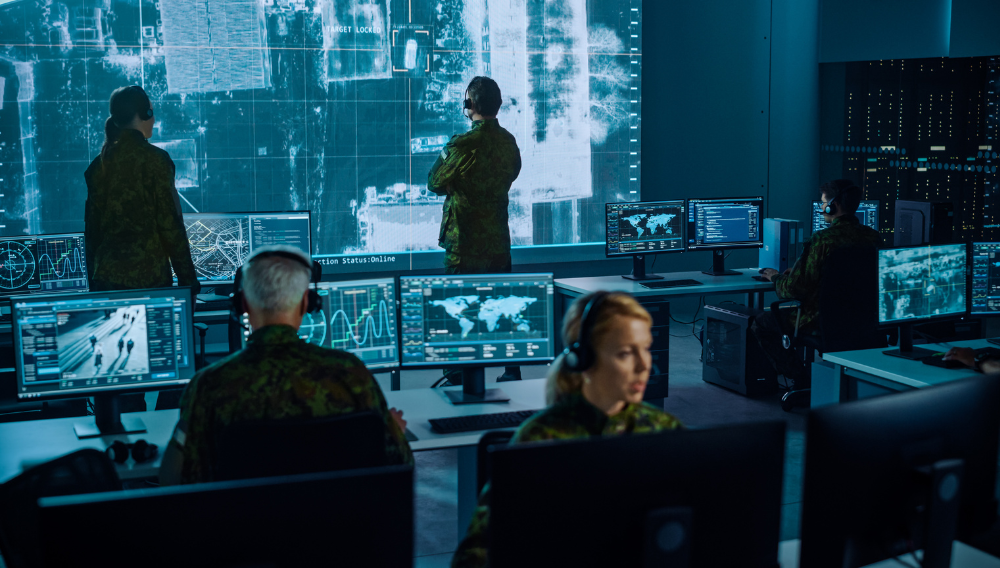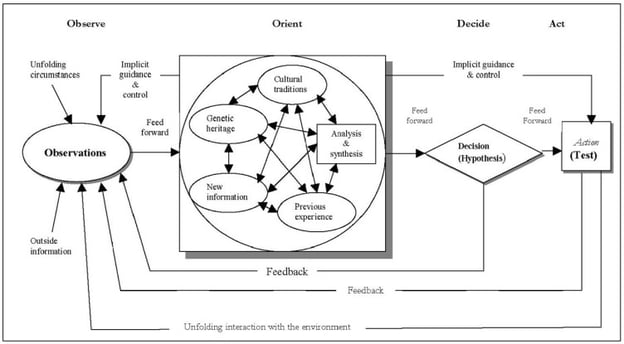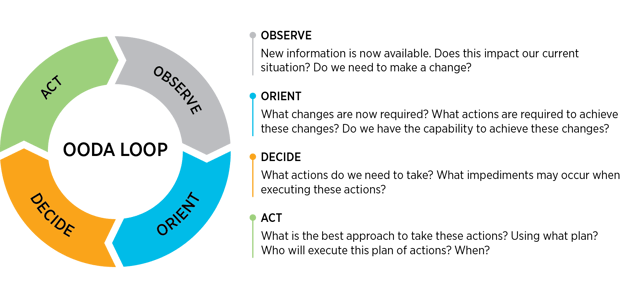
Part 4 of the JADC2 Blog Series
Evolving the OODA Loop to the Sense, Make Sense, Act process cycle
What is the definition of the OODA Loop? The OODA Loop is an analysis and decision-making process developed by Colonel John Boyd, a U.S. Air Force military strategist. It is designed to function as a framework for rational thinking and decision-making in confusing, contested, or chaotic situations, typically those characterized by incomplete and/or insufficient data. It was initially used to train operational planners to make time-sensitive decision recommendations rapidly when there may not be time to gather all the information required.
The OODA Loop decision-making framework focuses on filtering information currently available, placing it into a relevant context, and then quickly making the most appropriate decision – all of this with the understanding that adjustments can be made at the speed of relevance as more data becomes available to drive more precise information-based awareness and insight.

Figure 1. Colonel John Boyd’s graphic of his OODA Loop
The OODA loop enables decision-makers to think critically, understand patterns, anticipate threats and neutralize them before they become critical. First developed in 1986 and widely put into practice in the mid-1990s, the OODA process describes a recurring cycle of observe–orient–decide–act wherein individuals or organizations can process information quickly, and hopefully understand and react to unfolding events more rapidly than an opponent. The objective is being able to "get inside" an opponent's decision cycle and gain the advantage by simply making critical decisions faster.
The OODA has evolved well beyond military decision-making and into commercial realms such as legal/litigation, law enforcement, financial planning, and cybersecurity. The graphic depiction of a modern OODA Loop has been significantly simplified and now looks similar to Figure 2.

Figure 2. Modern OODA Loop Graphic
Compressing the OODA Loop into Sense, Make Sense, Act
Essentially, the OODA Loop was designed to help individuals and organizations make effective decisions faster. So how can JADC2 accelerate this decision-making process to maintain a competitive edge over adversaries? The answer is simple – getting access to more complete intelligence faster, coupled with autonomous AI and ML agents to accelerate awareness, understanding, decisions, and actions.
In a previous blog, I discussed the JADC2 “placemat” diagram that detailed the Sense, Make Sense, Act process that is at the core of JADC2 operations. The section below describes in greater detail this accelerated decision-making process.
.png?width=624&height=309&name=RTI-JADC2-OODA-Loop_2%20(1).png)
Figure 3. Detailed Sense, Make Sense, Act Loop: Accelerating the decision-making process
Sense: Integrate Data Across All Domains and the Electromagnetic Spectrum
Global systems of advanced sensing and information management technologies deliver an ever-increasing volume of data collected across all domains and operational environments. This data is accessed via federated data fabrics that use open standards and hardware/software interfaces to discover, classify and exchange data with authorized partners across all domains, echelons, and security levels. This sensor-dense ecosystem exploits remote sensors, intelligence assets, and open sources to sense and simultaneously integrate and fuse data from and within all domains to enable the Joint Force Commander to achieve information dominance, faster understanding, and a decision-making advantage.
"Sense and integrate" is the ability to discover, collect, correlate, aggregate, and process data from all domains and sources (friendly, adversary, and neutral), and appropriately distribute it as the basis for true information-driven insight. The requirements for effective data integration must be considered from the earliest stages of data sharing and security, and applied across the warfighting domains in order to deliver rapid collection, fusion, contextualization, and customization of real-time decision-making intelligence.
Make Sense: Understand the Operational Environment
"Make Sense" refers to analyzing information to better understand the context and anticipate changes in the operational environment. This may mean understanding the actions and intentions of an adversary, or interpreting the actions of our own and friendly forces. Raw data is transformed into curated information and that information transforms into knowledge and understanding. This transformation includes data-in-motion and stored data-at-rest, and fuses, analyzes, and renders validated data and derived information from all operational domains and the electromagnetic (EM) spectrum. One of the biggest challenges of sharing is that this function must execute within a secure information environment while remaining readily accessible to relevant users. Ultimately, a reliable and sustained real-time understanding of the operational environment must result. Such an understanding can be shared across the Joint Force and with designated mission partners. JADC2 capabilities will leverage Artificial Intelligence (AI) and Machine Learning (ML) to help accelerate the commander’s decision cycle. Automatic machine-to-machine transactions will extract, consolidate and process only the relevant data and information from the sensing infrastructure. Such improvements will require the Joint Force to adapt and modernize existing tactical, operational, and strategic C2 processes and capabilities, to include re-thinking how the U.S. Department of Defense (DoD) tests and integrates the Service’s discrete C2 capabilities into a larger and more powerful all-domain C2 capability.
The current conflict in Ukraine, for example, has illustrated challenges that contested EM spectrum can pose. A Sense, Make Sense, Act framework that can continue to assemble reliable, although reduced, data will mitigate the consequences of operating within a degraded environment. AI and ML can be used in this degraded environment to predict allied and adversary actions based on limited information. With more data delivered effectively, in optimal conditions, you win, and with more data delivered effectively in suboptimal conditions, you don't lose.
Act - Decide and Disseminate
To "Act" is to make and then disseminate decisions to the Joint Force and mission partners. It combines the human elements of decision-making with the technical means to perceive, understand, and envision the actions and intentions of adversaries, and then take decisive action. This includes accounting for the nuances of how a decision is delivered and how well a Commander’s direction is understood and executed. Planning and decision support applications will be employed across the Joint Force and underpinned by advanced, resilient and redundant communication systems, an accessible and comprehensive transport infrastructure, and flexible data formats. The aim is to ensure the rapid, accurate, and secure dissemination of decisions at the appropriate echelon.
To “Act” at the speed of combat requires subordinate commanders at all echelons within the Joint Force to be properly trained in and empowered by the tenets of Mission Command. Using a Mission Command approach, subordinate commanders are able to act with confidence and authority through understanding a senior commander’s operational intent, while retaining the flexibility to act when communications linkages are broken. All levels are able to take the initiative when the urgency of operations precludes the time necessary to seek guidance. Mission Command provides the agility and trust the Joint Force needs to assume responsibility for action and maintain their information and decision-making advantage.
Summary
The JADC2 Sense, Make Sense, and Act process will not only increase the fidelity of intelligence derived from global sensing assets, but also increase the speed and accuracy of resultant actions to maintain positional advantage ahead of adversarial actions. The consistent delivery of real-time data ensures that this process will be always evolving to understand, innovate, train, and respond appropriately to all adversarial actions.
For more information on how RTI supports the Sense, Make Sense, and Act process, please visit our JADC2 webpage.
Stay tuned to this JADC2 blog series as we continue to explore the requirements, challenges and successes of building and deploying JADC2 systems. Subscribe to the RTI Blog at the top of this post to ensure you receive the latest posts.
About the Author

Chip Downing is Senior Market Development Director, Aerospace & Defense, Real-Time Innovations, Inc.
Chair, FACE Business Working Group Outreach Subcommittee
Posts by Tag
- Developers/Engineer (180)
- Technology (79)
- Connext Suite (77)
- News & Events (75)
- 2020 (54)
- Aerospace & Defense (53)
- Standards & Consortia (51)
- Automotive (38)
- 2023 (34)
- 2022 (29)
- IIoT (27)
- 2025 (25)
- Leadership (24)
- Healthcare (23)
- 2024 (22)
- Connectivity Technology (21)
- Cybersecurity (20)
- 2021 (18)
- Culture & Careers (15)
- Military Avionics (15)
- FACE (13)
- Connext Pro (10)
- JADC2 (10)
- ROS 2 (10)
- Connext Tools (7)
- Connext Micro (6)
- Databus (6)
- Transportation (5)
- Case + Code (4)
- Connext (4)
- Connext Cert (4)
- Energy Systems (4)
- FACE Technical Standard (4)
- AI (3)
- Oil & Gas (3)
- Research (3)
- Robotics (3)
- Connext Conference (2)
- Edge Computing (2)
- Golden Dome (2)
- MDO (2)
- MS&T (2)
- RTI Labs (2)
- TSN (2)
- ABMS (1)
- C4ISR (1)
- DOD (1)
- ISO 26262 (1)
- L3Harris (1)
- LabView (1)
- MOSA (1)
- MathWorks (1)
- National Instruments (1)
- Simulation (1)
- Tech Talks (1)
- UAM (1)
- Videos (1)
- eVTOL (1)
 Success-Plan Services
Success-Plan Services Chip Downing
Chip Downing